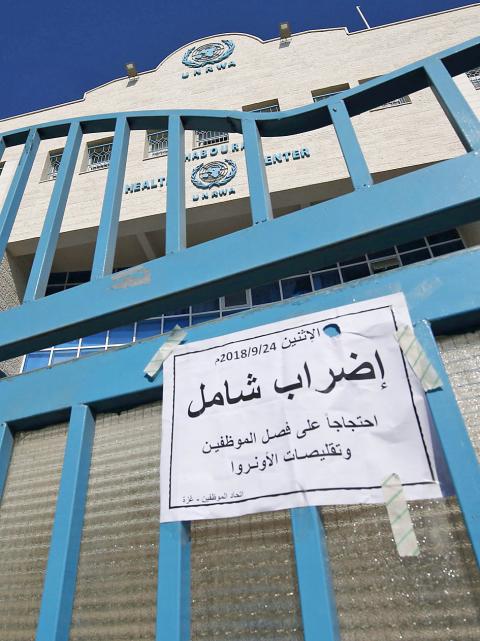The Gaza Strip’s economy is in “free fall” as cuts to aid and salaries add to an already crippling Israeli blockade on the Hamas-run enclave, the World Bank said on Tuesday.
The bank’s report is to be presented to the international donor group for Palestinians, known as the Ad Hoc Liaison Committee, tomorrow at its meeting on the sidelines of the UN General Assembly in New York City.
The meeting is to coincide with the speeches to the assembly of Palestinian President Mahmoud Abbas and Israeli Prime Minister Benjamin Netanyahu.

Photo: AFP
Already squeezed by a more than decade-long Israeli blockade, Gaza’s economy has been further weakened by US aid cuts and financial measures by Abbas’ Palestinian Authority.
Abbas has been seeking to pressure Islamic movement Hamas, which expelled his loyalists from the territory in 2007, as well as save costs.
He has reduced monthly payments to Gaza by about US$30 million, according to the World Bank.
US President Donald Trump’s administration has cut more than US$500 million in aid to the Palestinians, including ending all support for the UN Relief and Works Agency for Palestine Refugees.
“The economic deterioration in both Gaza and West Bank can no longer be counteracted by foreign aid, which has been in steady decline, nor by the private sector, which remains confined by restrictions on movement, access to primary materials and trade,” the bank said.
Gaza’s economy shrunk by 6 percent in the first quarter of this year “with indications of further deterioration since then,” it said.
One in two Gazans now lives below the poverty line and unemployment is 53 percent, the bank said, adding that more than 70 percent of young people are jobless.
“Increased frustration is feeding into the increased tensions which have already started spilling over into unrest and setting back the human development of the region’s large youth population,” World Bank director for the West Bank and Gaza Marina Wes said.
On Thursday last week, UN envoy for the Middle East peace process Nickolay Mladenov told the UN Security Council that “Gaza can explode any minute.”
Israel and Palestinian militants in Gaza have fought three wars since 2008.
In recent months, mass protests along Gaza’s border with Israel have triggered repeated deadly clashes with the army, prompting warnings of the risk of a new conflict.
At least 187 Palestinians have been killed by Israeli fire since the protests began on March 30. One Israeli soldier has been killed in that time.
Israel says its actions are necessary to defend the border and accuses Hamas of using the protests as cover to attempt infiltrations and attacks.
Palestinians and human rights groups say protesters have been shot while posing no real threat.
Mladenov and Egyptian officials have been seeking to broker a long-term truce between Israel and Hamas, but those efforts have stalled in recent weeks.

CHIP RACE: Three years of overbroad export controls drove foreign competitors to pursue their own AI chips, and ‘cost US taxpayers billions of dollars,’ Nvidia said China has figured out the US strategy for allowing it to buy Nvidia Corp’s H200s and is rejecting the artificial intelligence (AI) chip in favor of domestically developed semiconductors, White House AI adviser David Sacks said, citing news reports. US President Donald Trump on Monday said that he would allow shipments of Nvidia’s H200 chips to China, part of an administration effort backed by Sacks to challenge Chinese tech champions such as Huawei Technologies Co (華為) by bringing US competition to their home market. On Friday, Sacks signaled that he was uncertain about whether that approach would work. “They’re rejecting our chips,” Sacks

NATIONAL SECURITY: Intel’s testing of ACM tools despite US government control ‘highlights egregious gaps in US technology protection policies,’ a former official said Chipmaker Intel Corp has tested chipmaking tools this year from a toolmaker with deep roots in China and two overseas units that were targeted by US sanctions, according to two sources with direct knowledge of the matter. Intel, which fended off calls for its CEO’s resignation from US President Donald Trump in August over his alleged ties to China, got the tools from ACM Research Inc, a Fremont, California-based producer of chipmaking equipment. Two of ACM’s units, based in Shanghai and South Korea, were among a number of firms barred last year from receiving US technology over claims they have

It is challenging to build infrastructure in much of Europe. Constrained budgets and polarized politics tend to undermine long-term projects, forcing officials to react to emergencies rather than plan for the future. Not in Austria. Today, the country is to officially open its Koralmbahn tunnel, the 5.9 billion euro (US$6.9 billion) centerpiece of a groundbreaking new railway that will eventually run from Poland’s Baltic coast to the Adriatic Sea, transforming travel within Austria and positioning the Alpine nation at the forefront of logistics in Europe. “It is Austria’s biggest socio-economic experiment in over a century,” said Eric Kirschner, an economist at Graz-based Joanneum

OPTION: Uber said it could provide higher pay for batch trips, if incentives for batching is not removed entirely, as the latter would force it to pass on the costs to consumers Uber Technologies Inc yesterday warned that proposed restrictions on batching orders and minimum wages could prompt a NT$20 delivery fee increase in Taiwan, as lower efficiency would drive up costs. Uber CEO Dara Khosrowshahi made the remarks yesterday during his visit to Taiwan. He is on a multileg trip to the region, which includes stops in South Korea and Japan. His visit coincided the release last month of the Ministry of Labor’s draft bill on the delivery sector, which aims to safeguard delivery workers’ rights and improve their welfare. The ministry set the minimum pay for local food delivery drivers at